Botanical Name: Acanthus mollis
Common Name: bears breeches
Family: Acanthaceae
Distribution/Origin: southern Europe, north western Africa
Leaf: deeply lobed, soft-spiny, glossy dark green, basal foliage, toothed margins, compound, long petiole
Bud: spiky layered flower buds, almost resembles green pine cones
Flower: creamy white to pink, tubular, hooded and subtended by spiny reddish purple bracts, on top of spikes rising above foliage
Fruit/Seed: ovoid capsule, 2-4 large black seeds, dispersed by wind
Stem/Bark: thorny sepals, upright stems
Size: 3-5' height, 2-5' spread
Habit: spreads aggressively in loose soils,
Form: clumping, mounding
Soil conditions: average, fertile, tolerates wide range but must be well drained
Moisture: medium, tolerant of drought
Sun: full sun to partial shade (plants will not flower in heavy shade)
Exposure:
Landscape use: blooms June-July, invasive nature, perennial beds, xeriscaping, beds and borders, cottage gardens
Notes: leaves are prominent in classic Greek and Roman architecture and art, often seen in stone carvings from 4th century B.C

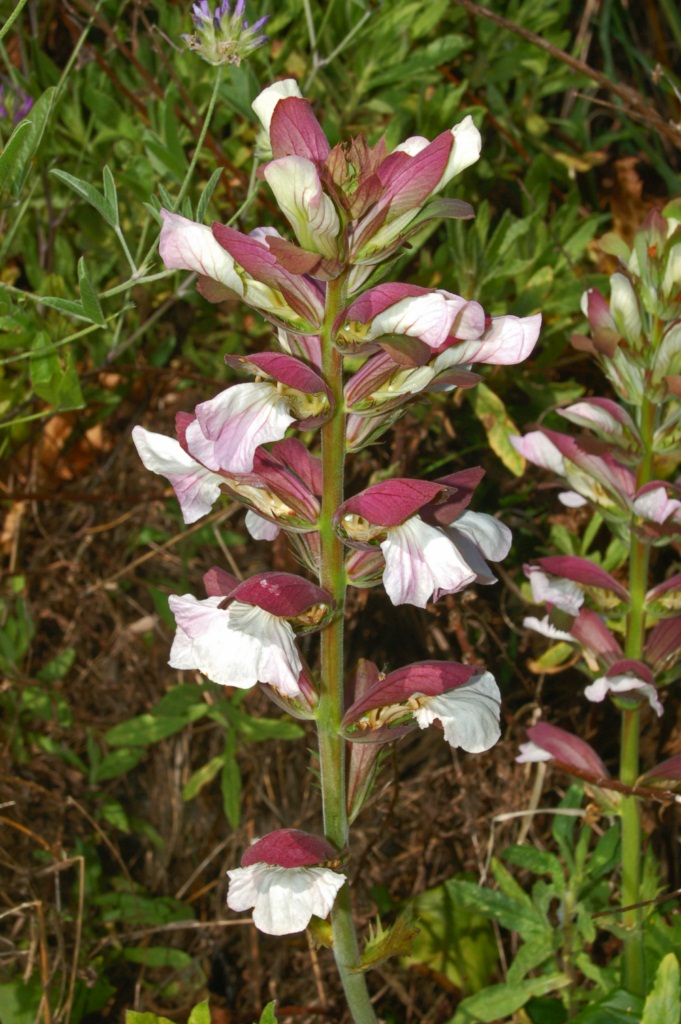
Botanical Name: Aconitum napellus
Botanical Name: Aconitum napellus
Common Name: monks hood
Family: Ranunculaceae
Distribution/Origin: western and central Europe
Leaf: deeply lobed, rounded, palmately divided, serrated margins
Bud: alternate
Flower: narrow-oblong helmet/habit shaped, dense terminal racemes, hermaphrodite, bilaterally symmetrical
Fruit/Seed: dry capsule, splits when ripe
Stem/Bark: rigid, hairless
Size: 2-4 height, 1-2' spread
Habit: flowers borne on erect stems, spreading
Form: upright, clumping
Soil conditions: moist, organically rich, well drained
Moisture: even moisture, cannot dry out
Sun: full sun to partial shade
Exposure: needs cool nights to grow well, can grow in full sun in cool areas
Landscape use: blooms July-August, flower borders and beds, perennial beds, cottage gardens
Notes: commonly called "wolfesbane" as plant was once used to poison the tips of arrows in killing wolves. Wear gloves when working with this plant!




Botanical Name: Alnus rubra
Common Name: red alder
Family: Betulaceae
Distribution/Origin: North America
Leaf: ovate, bluntly serrated edges, pointed apex, leaf margin curls under (distinguishing feature from other alders)
Bud: reddish brown, narrowly pointed, alternate, lateral buds stick out
Flower: male catkins, dangling, red in color, female catkins are erect
Fruit/Seed: female catkins develop into small woody cone like oval fruits, seeds develop between woody bracts of cones and shed in autumn and winter
Stem/Bark: mottled, ashy grey and smooth, often draped in moss, rusty grey color is shown if bark is bruised or scraped, prominent lenticels,
Size: 66-98' height, 1-3' spread
Habit: lower trunk usually free of branches due to intolerance of shade,
Form: open, broadly pyramidal, dome shaped crown
Soil conditions: sandy to loamy, average
Moisture: even moisture
Sun: sun to partial shade
Exposure: can handle maritime exposure
Landscape use: flowers March to April, woodland garden canopy, hedge, bog garden
Notes: largest species of alder in North America, as well as one of the largest in the world. Because of its oily smoke, it is a choice wood for smoking salmon. Yum!

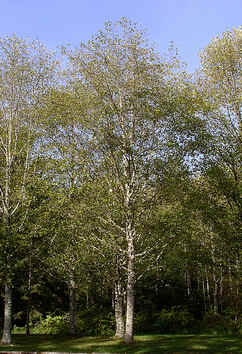
Botanical Name: Bergenia cordifolia
Botanical Name: Betula utilis
Botanical Name: Calluna vulgaris


Botanical Name: Bergenia cordifolia
Common Name: pig squeak
Family: Saxifragaceae
Distribution/Origin: Russia
Leaf: leathery, glossy, toothed margins, rounded, dark green, bronzy foliage in winter, cordate bases
Bud: rosette of leaves, flower buds in dense clusters
Flower: dense panicles of pink to purple flowers on large stocks
Fruit/Seed: 2 parted capsule
Stem/Bark: erect stems, often red to purple in color
Size: 1-2' height, 1-2' spread
Habit: tightly spreading
Form: clumping
Soil conditions: average, well drained, tolerant of many soil types but prefers moist humusy conditions
Moisture: medium
Sun: partial shade
Exposure:
Landscape use: blooms April-May, perennial beds, borders, groundcover, evergreen
Notes: called "pig squeak" due to the noise when foliage is rubbed between fingers




Botanical Name: Betula utilis
Common Name: white bark birch
Family: Betulaceae
Distribution/Origin: western China
Leaf: ovate, doubly serrate margins, greenish yellow in color,
Bud: alternate, reddish brown, scaled
Flower: yellowish brown male catkins, green female catkins
Fruit/Seed: drooping cone like fruits containing numerous small winged nutlets
Stem/Bark: white exfoliating to orange, paper like bark, shiny horizontal lenticels, peeling/exfoliating, very hard and heavy wood, heartwood is pink to reddish brown
Size: 30-40' height, 18-25' spread
Habit: upright, ascending branches
Form: open, pyramidal
Soil conditions: well drained, sandy to loamy soils
Moisture: medium to wet (in the wild is dependent on snow melt)
Sun: full sun to partial shade
Exposure: best sited in northern to or eastern exposure, consider using bark mulch to keep root zones cool and moist
Landscape use: blooms April-May,
Notes: used traditionally as paper for scriptures and text, or paper for books. Specific epithet means useful



Botanical Name: Calluna vulgaris
Common Name: heather
Family: Ericaceae
Distribution/Origin: Europe, Asia Minor, northern North America
Leaf: scale like leaves, borne in opposite and decussate pairs, whorls of 3-4 sometimes 5
Bud: opposite
Flower: urn shaped, incomplete fusion, terminal in racemes, sepal like bracts, sometimes double flowers
Fruit/Seed: fruit like capsule
Stem/Bark: thin, smooth
Size: 1-2' height, 1-2' spread
Habit: scraggly, older shrubs become unkempt and benefit from spring pruning
Form: small clumps, thick mats of foliage in ideal conditions
Soil conditions: well drained, humusy, lean, sandy or gravelly
Moisture: dry to moist
Sun: full sun to partial shade
Exposure: tolerant of grazing, regenerates following occasional burning, do not expose to strong winds
Landscape use: blooms May-November, ornamental gardening, beds, borders, ground cover
Notes: despised until the 19th century for its association with rugged rural poverty. Important food source for grazing animals during winter months. Also was used to brew beer before hops began to take off during the middle ages.

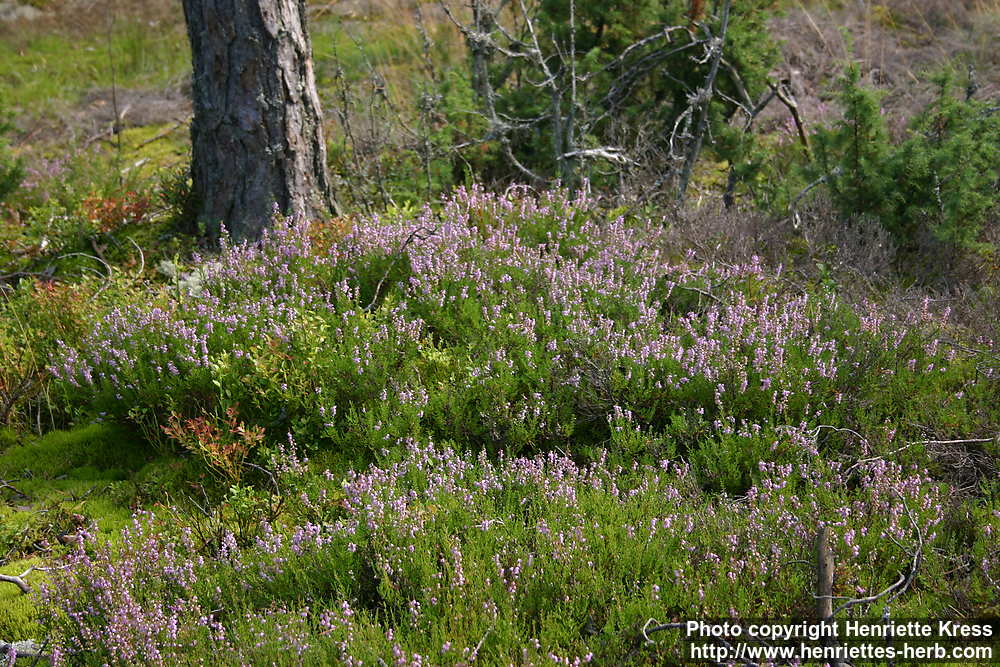
Botanical Name: Corylus avellana 'Contorta'


Botanical Name: Corylus avellana 'Contorta'
Common Name: Harry Lauder's walking stick
Family: Betulaceae
Distribution/Origin: Europe
Leaf: twisted, round, double toothed margins
Bud: plump, alternate arrangement, small
Flower: brown male catkins, female insignificant - red styles of the pistils protruding from bud scales
Fruit/Seed: species commonly grown for nuts, this cultivar does not produce fruit
Stem/Bark: curled contorted stems, heavy lenticels
Size: 8-10' height, 8-10' spread
Habit: multistemmed, contorted branching
Form: irregularly rounded
Soil conditions: average, medium, well drained
Moisture: medium
Sun: full sun to partial shade
Exposure:
Landscape use: April bloom time, hedgerow, winter interest, specimen, shrub border
Notes: sold in grafted form, remove suckers as they will not have contorted form

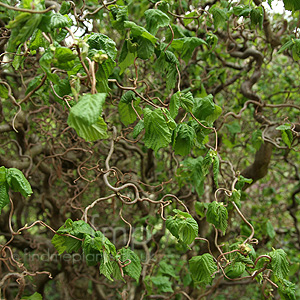
Botanical Name: Daboecia cantabrica


Botanical Name: Daboecia cantabrica
Common Name: Irish heath
Family: Ericaceae
Distribution/Origin: Europe
Leaf: ovate, elliptical, leathery, white or silver undersides, occasional hairs
Bud:
Flower: nodding, terminal racemes, urn shaped, white purple or pink in color, born on erect spikes
Fruit/Seed: insignificant capsule
Stem/Bark: light brown stems, occasional hairs, thin stems
Size: 12-18" height, 12-15" spread
Habit: multistemmed, spreading, evergreen
Form: compact mounds
Soil conditions: organically rich, well drained
Moisture: even moisture, somewhat drought tolerant
Sun: full sun, dappled shade
Exposure:
Landscape use: mosaic plantings, ground cover, borders, blooms June-October
Notes: named after an obscure Irish saint "Saint Beoc", with a slight name adjustment to "da" ("thine"), and "mo" meaning "my" which are Irish endearments for saints... who didn't make the cut for being well known on the list of Irish saints. The connection of why the heather was linked to this man is lost, though speculation was made that he used to bless it and use it to sprinkle holy water on the Celtic folks.

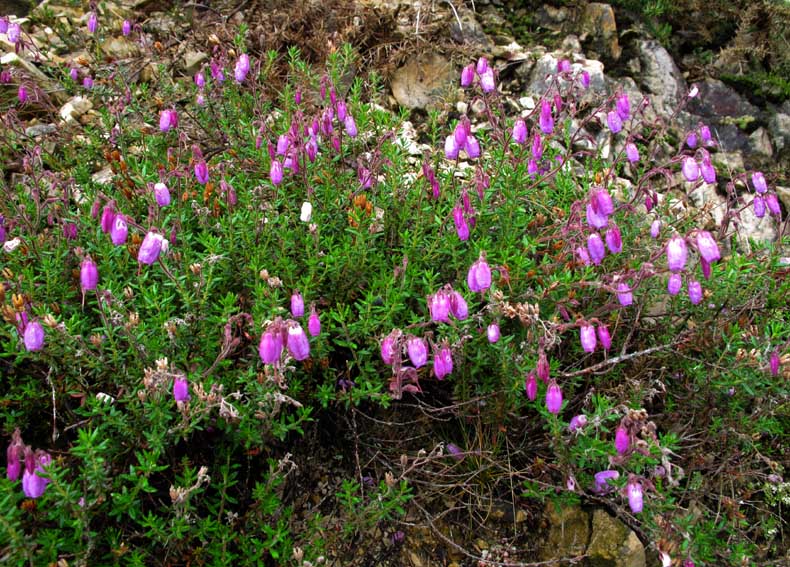
Botanical Name: Erica arborea


Botanical Name: Erica arborea
Common Name: tree heath
Family: Ericaceae
Distribution/Origin: Mediterranean
Leaf: dark green, whorled, needle like, simple
Bud:
Flower: sweetly scented, panicles of white urn shaped flowers
Fruit/Seed: dry red capsules
Stem/Bark: older growth is furrowed, grey to brown stems with light fissuring
Size: 4-13' height, 3-9' spread
Habit: arborescent/bushy, multistemmed
Form: tight mounds, globose, upright, taller than wide
Soil conditions: well drained, sandy loams
Moisture: dry to moist
Sun: full sun
Exposure:
Landscape use: blooms early to mid spring, shrub borders, perennial beds, scent garden
Notes: the wood, known as briar root, is extremely hard and heat resistant; traditionally used to craft smoking pipes.


Botanical Name: Erica carnea
Botanical Name: Heuchera hybrids


Botanical Name: Erica carnea
Common Name: winter heather
Family: Ericaceae
Distribution/Origin: central, southern Europe
Leaf: evergreen, needle like leaves, in whorls of 4, linear
Bud:
Flower: racemes, urn shape, dark reddish to pink, sometimes white
Fruit/Seed: brown capsules, not showy
Stem/Bark: smooth brown to red stems
Size: 4-10" height, up to 23" spread
Habit: low growing sub-shrub, upright, multistemmed
Form: mounding, creeping, mat like
Soil conditions: well drained, average, tolerates acidic and alkaline soils
Moisture: moist
Sun: full sun to partial shade
Exposure:
Landscape use: groundcover, winter flowering, borders, beds
Notes: very neat plant that blooms in the winter



Botanical Name: Heuchera hybrids
Common Name: coral bells
Family: Saxifragaceae
Distribution/Origin: North America
Leaf: varying colors (many cultivars), palmately lobed, long petioles, simple, ovate, cordate bases
Bud:
Flower: spikes of small dainty flowers, bell shaped, racemes, floriferous
Fruit/Seed: insignificant
Stem/Bark: dense low growing clumps with tall slender stems with flowers
Size: 1-2' height, 1-2' spread
Habit: spreading
Form: clumping
Soil conditions: organically rich, humusy, well drained
Moisture: medium, foliage will decline if allowed to dry out completely
Sun: full sun to partial shade
Exposure:
Landscape use: bloom period June-July, mass plantings, ground cover, borders, rock gardens
Notes: many, many varieties to choose from for foliage colors


Botanical Name: Holodiscus discolor


Botanical Name: Holodiscus discolor
Common Name: oceanspray
Family: Rosaceae
Distribution/Origin: western North America
Leaf: small, long and broad, lobed, green, simple, obovate, pinnately lobed
Bud: alternate
Flower: cascading drooping white flowers, clustered, faint sugary scent, panicles, perfect
Fruit/Seed: small hairy fruit containing 1 seed which is dispersed by the wind
Stem/Bark: peeling white to brown bark
Size: 9-15' height, 13-16' spread
Habit: multistemmed, arched branching
Form: loosely rounded mounds, airy appearance with flowers in bloom, twiggy
Soil conditions: humusy, rich, well drained
Moisture: even moisture to dry
Sun: full sun, partial shade
Exposure: can withstand drought
Landscape use: blooms June-August, accent shrub, habitat for birds, insects, garden beds
Notes: very hard wood, often used for weapons by native tribes

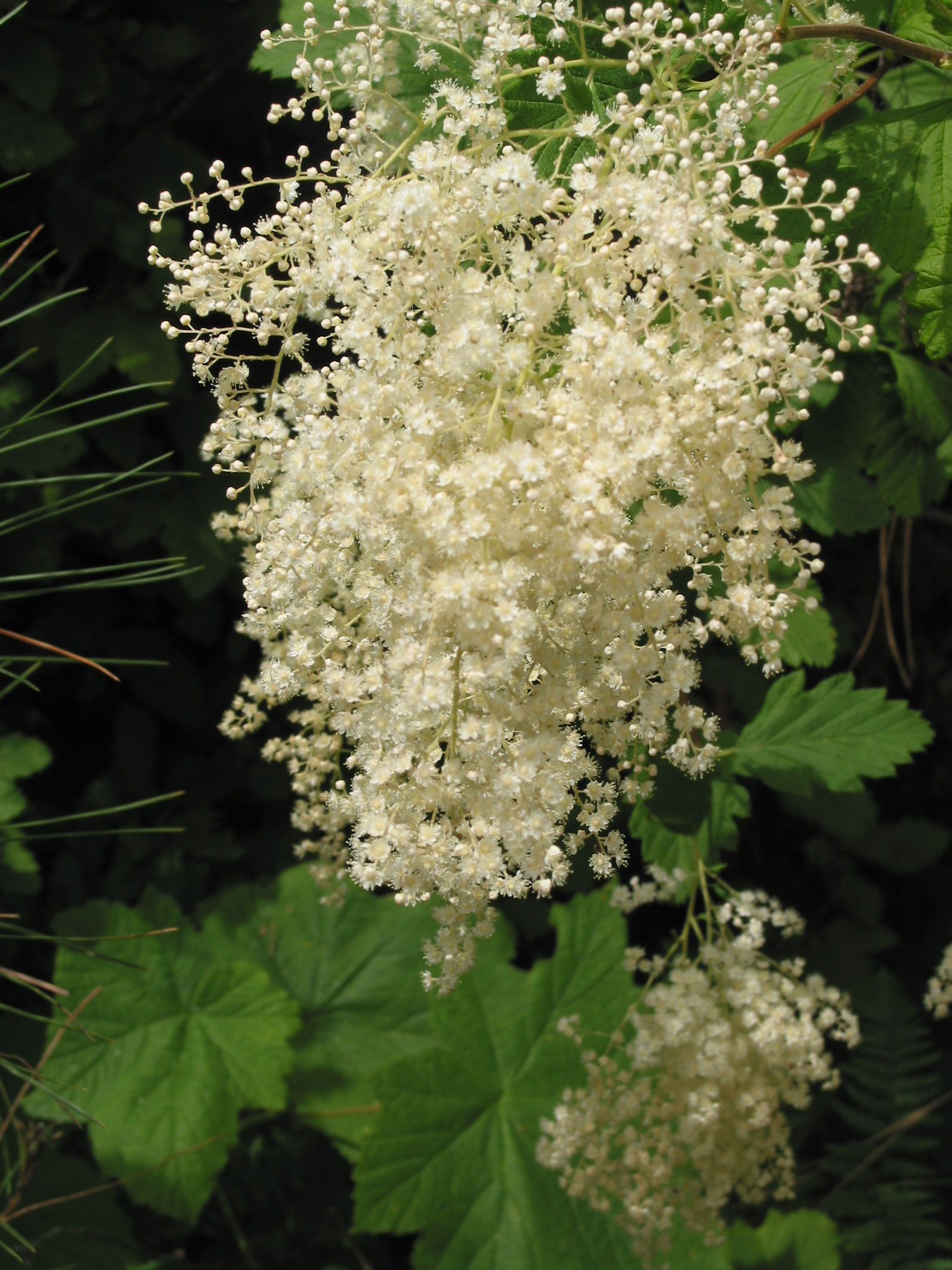
Botanical Name: Nothofagus antarctica


Botanical Name: Nothofagus antarctica
Common Name: Antarctic beech
Family: Fagaceace
Distribution/Origin: South America
Leaf: compound, large ovate, dense, wavy and irregular margins (crenate), foliage lightly scented
Bud: alternate
Flower: scented like cinnamon, monoecious pale green flowers, small and solitary on leaf axils, male flowers are clustered in 5's, females occur in groups of 1-3 wrapped in bracts
Fruit/Seed: small nuts, usually in 3's, with 4 valved capsules
Stem/Bark: white lenticels, hard and elastic, smooth dark brown, flaky bark with age
Size: 30-40' height, up to 15' spread
Habit: suckering from base, irregular, pendulous branching
Form: open irregular crown,
Soil conditions: wide range of soil types, prefers fertile and acidic, well drained
Moisture: even moisture
Sun: full sun or dappled shade
Exposure: drought tolerant when established
Landscape use: street tree, ornamental
Notes: its occurance on the Hoste Island earns it the title of the southernmost tree on Earth

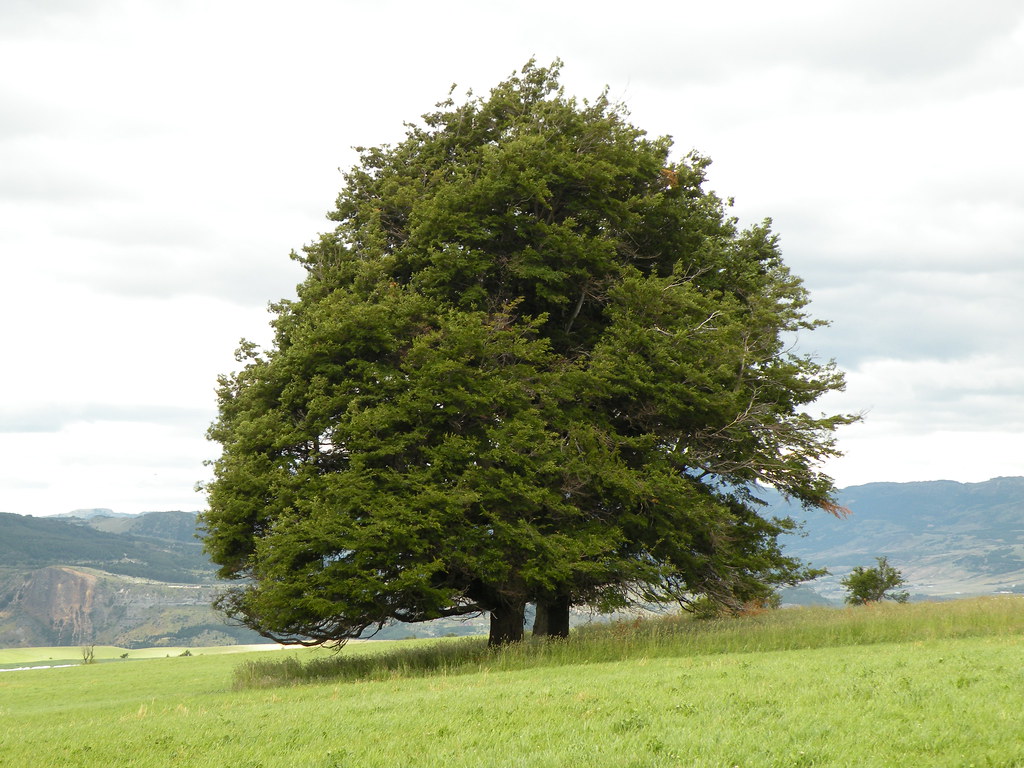
Botanical Name: Physocarpus opulifolius
Botanical Name: Potentilla fruticosa


Botanical Name: Physocarpus opulifolius
Common Name: eastern nine bark
Family: Rosaceace
Distribution/Origin: western North America
Leaf: ovate to rounded, 3-5 lobed leaves, dull green during warm season giving way to yellow in fall
Bud: alternate, scales overlapping on buds like shingles
Flower: small pink or white corymbs, five petaled
Fruit/Seed: drooping clusters of reddish fruit that are inflated seed capsules
Stem/Bark: exfoliating, peels in strips to reveal reddish to light brown inner bark
Size: 5-8' height, 4-6' spread
Habit: suckering, spreading,
Form: upright,
Soil conditions: average, slightly acidic, well drained
Moisture: dry to medium
Sun: full sun to partial shade
Exposure: tolerates drought and poor soils, good for erosion
Landscape use: winter interest, bloom period May-June, hedge, shrub borders, erosion control on banks
Notes: common name comes from plants characteristic for bark to peel away in layers and reveal interesting contrasting colors



Botanical Name: Potentilla fruticosa
Common Name: shrubby cinquefoil
Family: Rosaceae
Distribution/Origin: native to every continent in the northern hemisphere
Leaf: pinnately divided, 7 lobes, linear oblong, entire margins, pubescent
Bud: alternate
Flower: terminally on stems, buttercup shaped, 5 petaled, 15-25 stamens, pale and bright yellow in color
Fruit/Seed: cluster of archenes covered with long hairs
Stem/Bark: older bark is shredded
Size: 4-5' height, up to 4' spread
Habit: variably upright to sprawling, stems ascending, dense foliage
Form: rounded
Soil conditions: average, well drained
Moisture: prefers moist soils, can tolerate dry conditions
Sun: full sun to semi shade
Exposure: cold tolerant, drought tolerant, very tough plant
Landscape use: flowers early to late summer, ornamental, woodland garden, groundcover, hedge, parking lot meridians
Notes: the dry flaky bark is useful for a friction tinder


Botanical Name: Quercus garryana


Botanical Name: Quercus garryana
Common Name: Garry oak
Family: Fagaceace
Distribution/Origin: southern North America
Leaf: broad, 3-7 lobes, oblong to ovate, dark green, leathery, tomentose surfaces
Bud: terminal buds furry, conical and ovoid in shape, alternate, leafy stipules
Flower: catkins, male and female, monoecious, colored brown, pollinated by wind, not showy
Fruit/Seed: small acorn with shallow scaly cups, brown
Stem/Bark: large contorted branches, shoots are orange-red, hairy, fissured, grey to tan in color
Size: 72-98' height, 32-49' spread
Habit: irregular, open, spreading, twiggy, upright
Form: oval profile when solitary, grown in groves crowns form a canopy, rounded
Soil conditions: rocky or gravelly, well drained
Moisture: low moisture, can handle dry conditions
Sun: sun to partial shade
Exposure: tolerant of heavy winds
Landscape use: naturalized areas, meadows, shade tree, wildlife food, wind break, specimen plant
Notes: named after Nicholas Garry, deputy governor of the Hudson's Bay company (1822-1835)

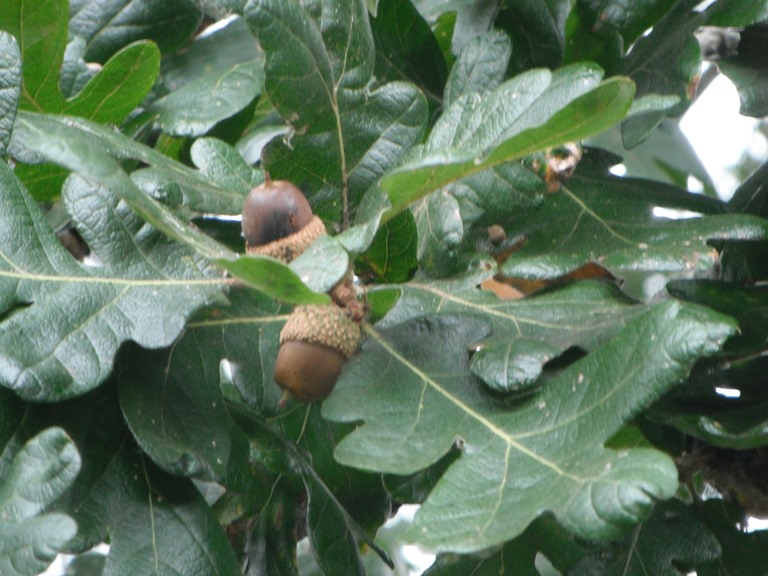
Botanical Name: Quercus ilex


Botanical Name: Quercus ilex
Common Name: holly oak
Family: Fagaceae
Distribution/Origin: Mediterranean
Leaf: dark green surfaces, pale whitish grey undersides with dense short hairs, variable shape, older leaf margins are entire while young are somewhat toothed/spiny
Bud: alternate, small, tawny in color, with recurved scales
Flower: drooping male catkins, 4-7 stamens longer than petals, pistillate flowers with bracts
Fruit/Seed: acorn, pointed, short peduncle, enclosed by scaly cup
Stem/Bark: plated bark, squarely fissured
Size: 66-89' height, up to 65' spread
Habit: multibranched, irregular branching pattern
Form: rounded, large
Soil conditions: well drained, wide range of soils
Moisture: even moisture
Sun: sun to semi shade
Exposure:
Landscape use: clipped to a hedge for windbreak, woodland garden canopy
Notes: hard and tough wood used since ancient times for pillars or wagons
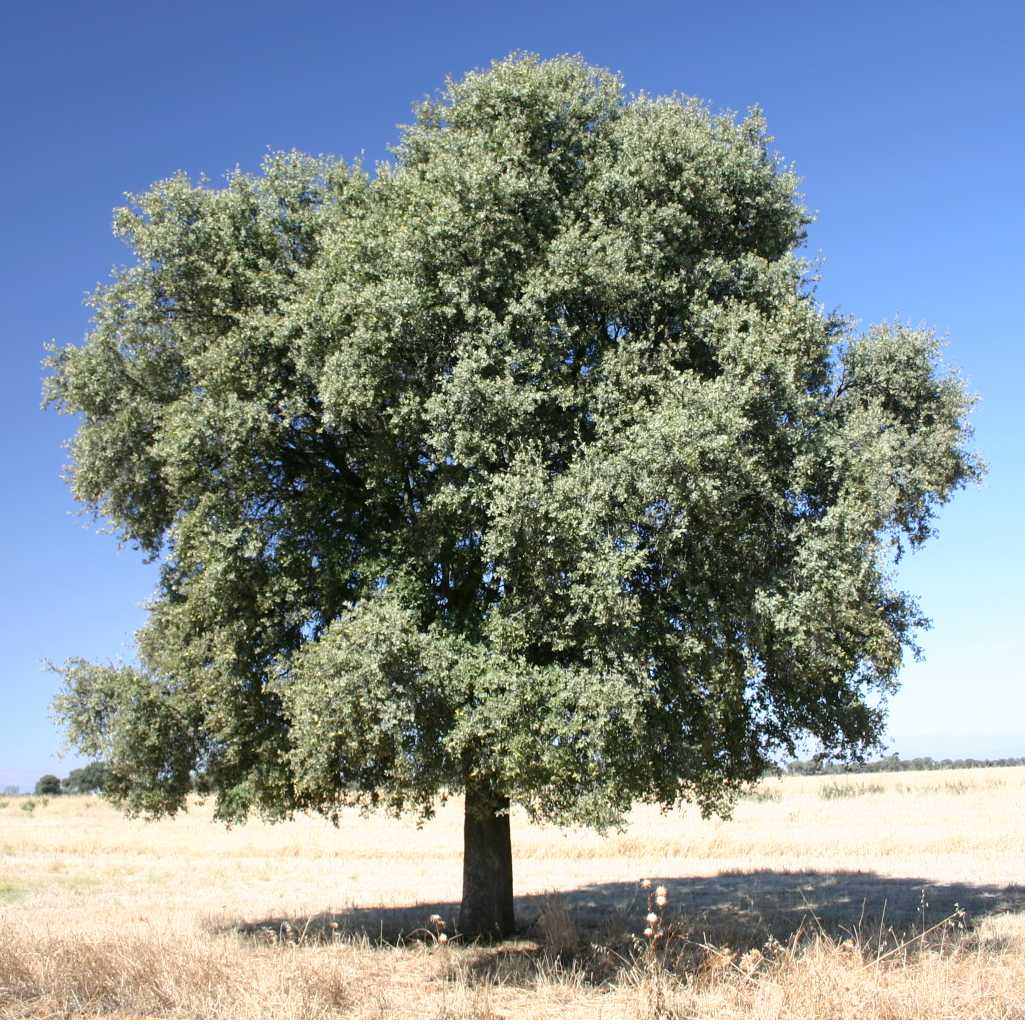

Botanical Name: Quercus rubra
Botanical Name: Sarracenia purpurea


Botanical Name: Quercus rubra
Common Name: northern red oak
Family: Fagaceae
Distribution/Origin: North America
Leaf: simple, lobed, pinnate venation, glabrous surface, elliptic to ovate, cleft margins
Bud: dark red at terminals, small and brown with small scales, alternate
Flower: green catkins
Fruit/Seed: brown acorns, edible, not showy, cup is saucer shaped and shallow, solitary or in pairs
Stem/Bark: smooth, lightly fissured, grey to brown
Size: 72-98' height, 45-82' spread
Habit: spreading, stiffly upright
Form: rounded
Soil conditions: average soils, well drained
Moisture: medium
Sun: full sun
Exposure:
Landscape use: specimen plant, autumn interest, food for creatures, parks, gardens
Notes: wood grain is so open that smoke can be blown through it end grain to end grain on a flat-sawn board, unless treated properly it is unsuitable for outdoor construction

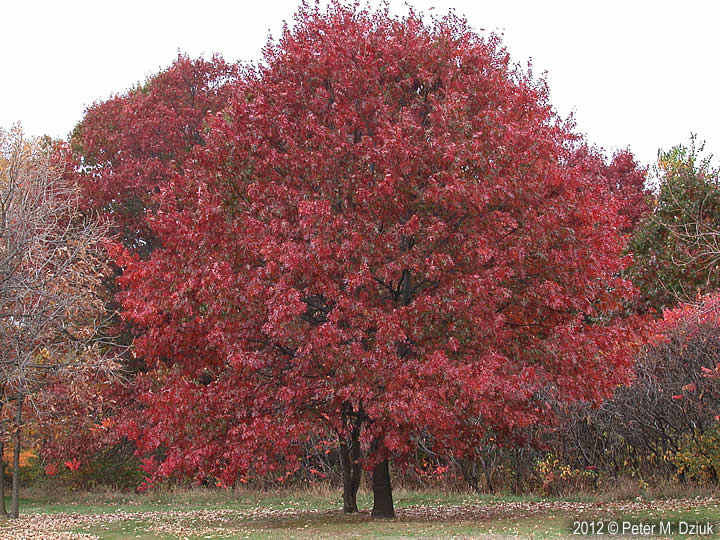


Botanical Name: Sarracenia purpurea
Common Name: pincher plant
Family: Serraceniaceae
Distribution/Origin: North America
Leaf: trumpet shaped pitchers (modified leaves), irregular, hairs inside tubes to trap insects, interesting patterns and colors (helpful in attracting prey)
Bud:
Flower: simple, globular
Fruit/Seed: 5 chambered capsule
Stem/Bark:
Size: 1-1.5' height, 1-2' spread
Habit: upright, evergreen
Form: basal
Soil conditions: acidic soils, heavy, leeching, mucky constantly damp but not watery
Moisture: wet
Sun: full sun
Exposure: cold climates
Landscape use: bloom time May-June, specimen plant, reduce insect populations, water plant, rain garden
Notes: feeds on insects for nitrogen by luring them in to cups with chemicals they smell which paralyzes them, can help reduce insect populations. Also the floral emblem for Newfoundland and Labrador
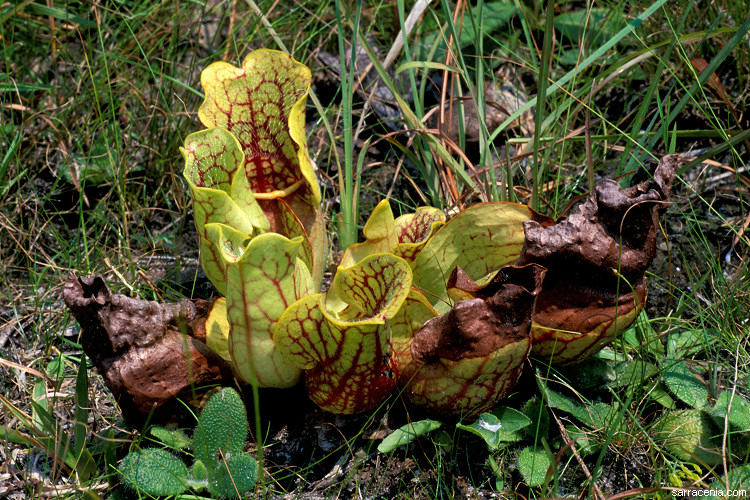

Botanical Name: Viburnum x bodnantense


Botanical Name: Viburnum x bodnantense
Common Name: Bodnans viburnum
Family: Adoxaceae
Distribution/Origin: garden origin
Leaf: lightly serrate, elliptical, glossy surface, pinnate venation
Bud: opposite, ovoid
Flower: fragrant, clusters of white to pink cymes, hermaphrodite
Fruit/Seed: red-blue-black flattened drupes, containing single seed, sometimes absent
Stem/Bark: grey to brown, fissuring, lightly exfoliating
Size: up to 9' height and 8' spread
Habit: suckering, multistemmed, leggy branches, bushy
Form: loosely rounded, upright
Soil conditions: well drained, average, moderately fertile
Moisture: even moisture
Sun: full sun to partial shade
Exposure:
Landscape use: blooms November to March, woodland garden, borders, beds
Notes: hybrid between V. farreri x V. Grandiflorum, and is popular for the strongly scented flowers




No comments:
Post a Comment